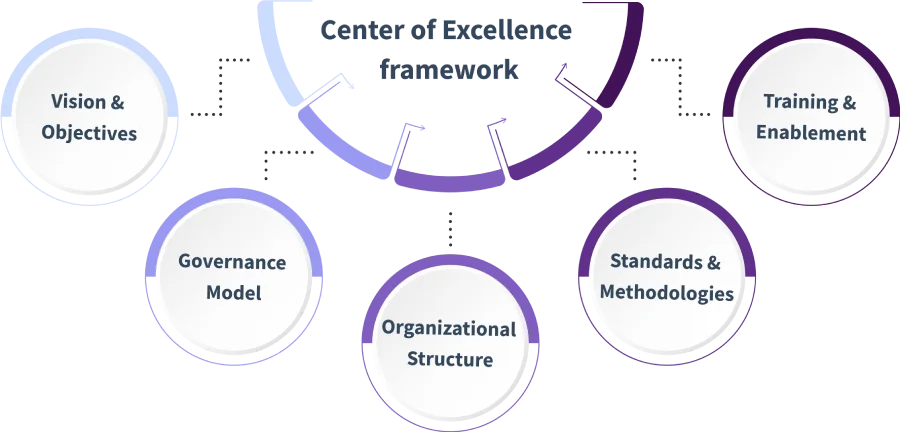Home / C / Center of Excellence (CoE)
Many companies have adopted a Center of Excellence (CoE) as a strategic unit to unify expertise, streamline best practices, strengthen governance, and foster innovation within a specific domain. In the modern business environment, regardless of whether an HR centre of excellence, analytics CoE or a functional CoE, its mission is to implement consistency, efficiency, and business-aligned outcomes between teams. The present blog will teach you what CoE is, what a center of excellence framework is, what the types of CoE are, how to create a center of excellence, center of excellence real-life examples, center of excellence program objectives, and what the main benefits are that it can bring to you.
A center of excellence aggregates industrial specialists, tooling, sharing, and conducting procedures to drive raised methods within the whole enterprise. It assists in aligning such focused skills as analytics, HR, digital transformation, or innovation with the overall strategy of the business. In compliance with CoE, organizations promote scalability, agility, and continuous improvement without duplication and siloed knowledge.
A center of excellence framework brings organization establishment of roles, governance, and metrics using frameworks and dedicated teams. Developing a CoE, be it what is CoE in business or HR, center of excellence, involves well-defined objectives, stakeholder acceptance, and continuous review. All these factors are explained to you through this blog combined with the latest figures for 2024‑2025 to create credibility and trust.
A Center of Excellence (CoE) is a specialized unit within an organization that brings together expertise, processes, and resources to drive excellence in a specific domain that concentrates skills, processes and governance around a subject area, HR, analytics , innovation or technology, to help generate best practices, arrange implementation with strategy, and accrue continuous improvements.
CoE will protect knowledge and standards within a specific field; the level of practices can be repeated, measured, and confirmed to enterprise objectives. It helps to introduce homogeneity in business divisions, quickens the learning process, and even instills innovation into daily activities.
As a case in point, an HR center of excellence may manage talent acquisition, employee engagement , learning and development, and compensation policies by harmonizing the best practices across different geographies. That allows all departments to test methods instead of necessarily trying to develop a new version of the wheel.
In addition to standardization, a CoE promotes efficiency, i.e., reducing duplication, eliminating inferior processes, and increasing delivery speed. It also promotes innovation, trying new tools, developing new processes, and reproducing success throughout the organization.
A CoE will have disciplinary leaders, functional experts, analysts, and technologists gathered in one place to identify and carve out best practices.
It establishes common policies, methods, and quality requirements for projects.
CoEs also offer training, mentoring, and toolkits to implement pervasive competence.
They test new programs, processes, and tools, evaluate them, and create value, replicating successful programs and processes.
Each organization can create CoEs in different areas according to its strategic focus. The typical ones are:
Learning, compensation, diversity, and engagement.
Data governing bodies consolidate data governance, data analytics good practice, dashboards, and predictive models.
Enables the implementation of technology and standards of digital transformation.
Facilitates innovation models, testing, design thinking, and cross-functional ideations.
Regulates shared back-office operations, such as finance, procurement, and project management .

1. Vision & Objectives
2. Governance Model
3. Organizational Structure
4. Standards & Methodologies
5. Training & Enablement

Begin by determining the business problems that CoE is expected to address. The objectives should be strategy-focused, measured, and specific.
Earn a public endorsement by the top leadership to spur believability and secure financing. An executive sponsor is the liaison and the advocate for CoE to enterprise.
Choose a professional who has excellent domain understanding and teamwork skills. Have a balanced and diverse group as a core team by inviting cross-functional representation, analysts, technologists, and process owners.
Identify sensible governance with roles, specific responsibilities, and reporting relationships. Accountability, conflict resolution, and roadmap implementation can be achieved through a steering committee.
1. Better Efficiency and Productivity: CoEs eradicate duplication and silo-keeping and institute best practices as the CoEs did.
2. Employee Engagement and Retention: Active onboarding, as in the case of an organization with high onboarding, leads to retention of new- hires by up to 82% and productivity by 62%.
3. Scale Innovation: Non-CoEs will be able to innovate at scale by building upon pilot projects that were controlled using CoEs
4. Improves Talent Management: 80% of organizations will adopt AI in HR in 2025, and 78% consider HR a strategic business partner in business planning.